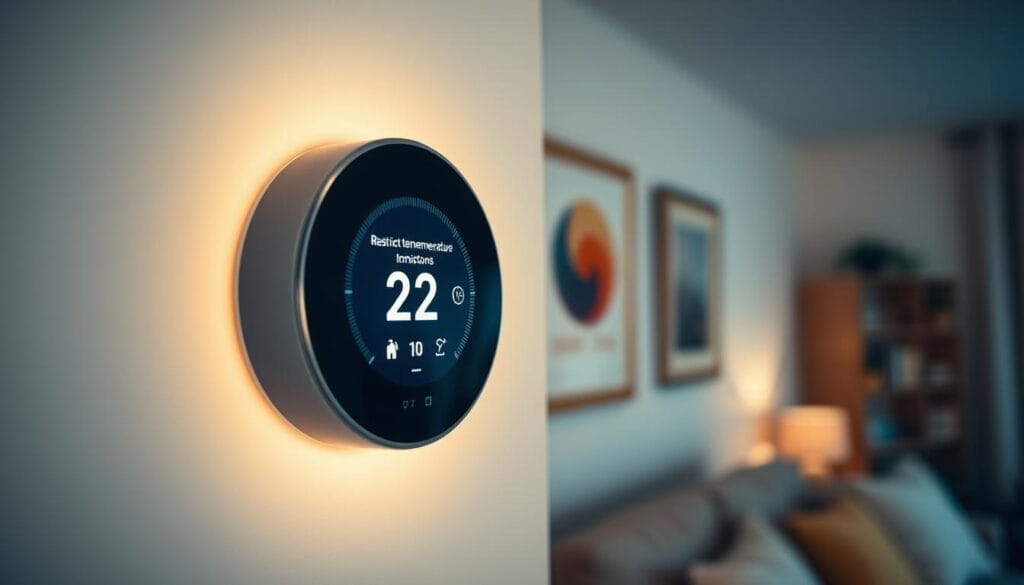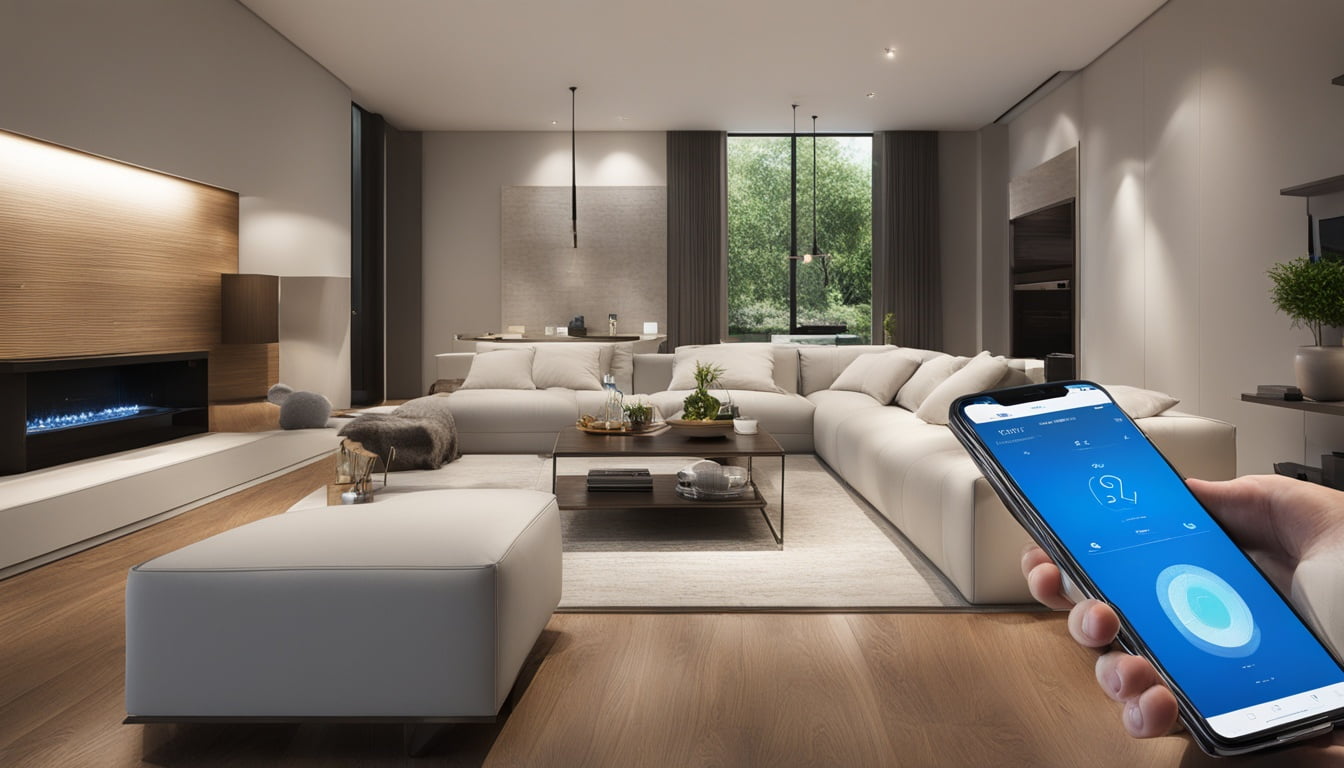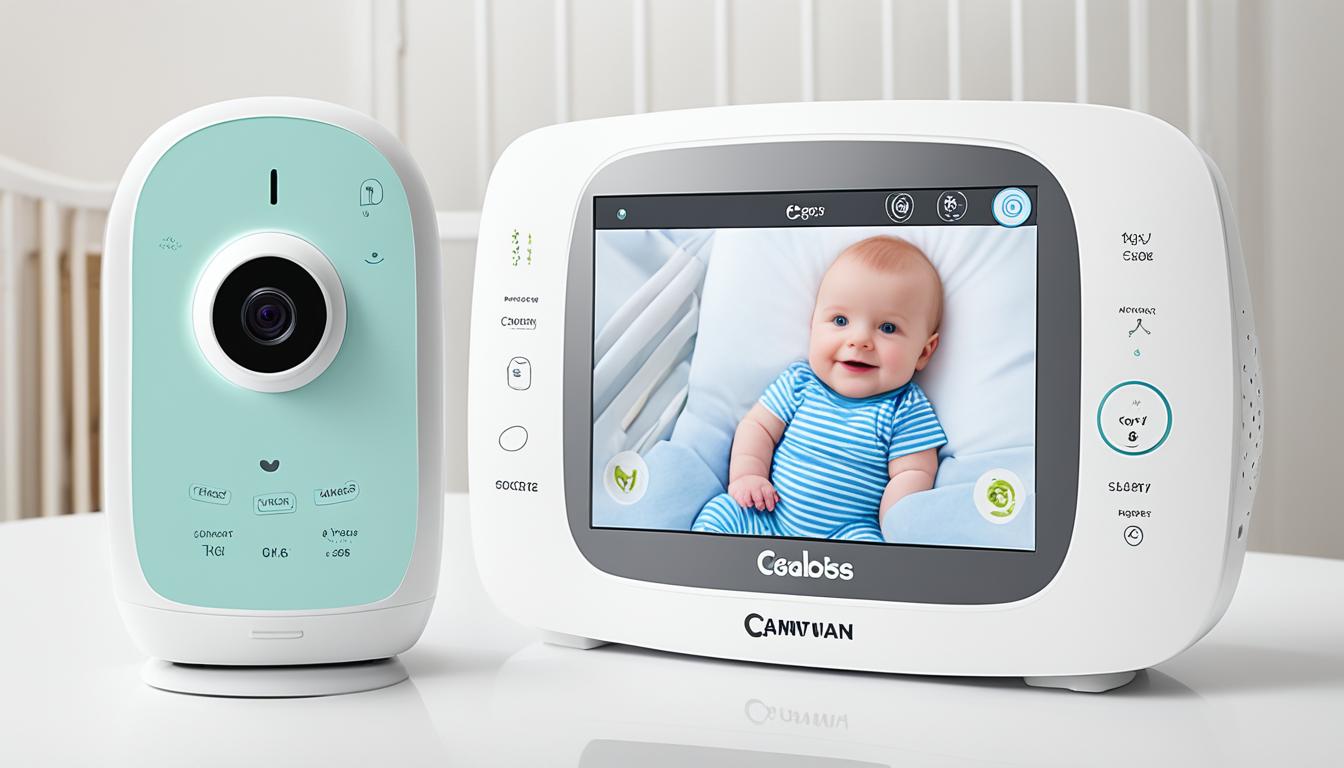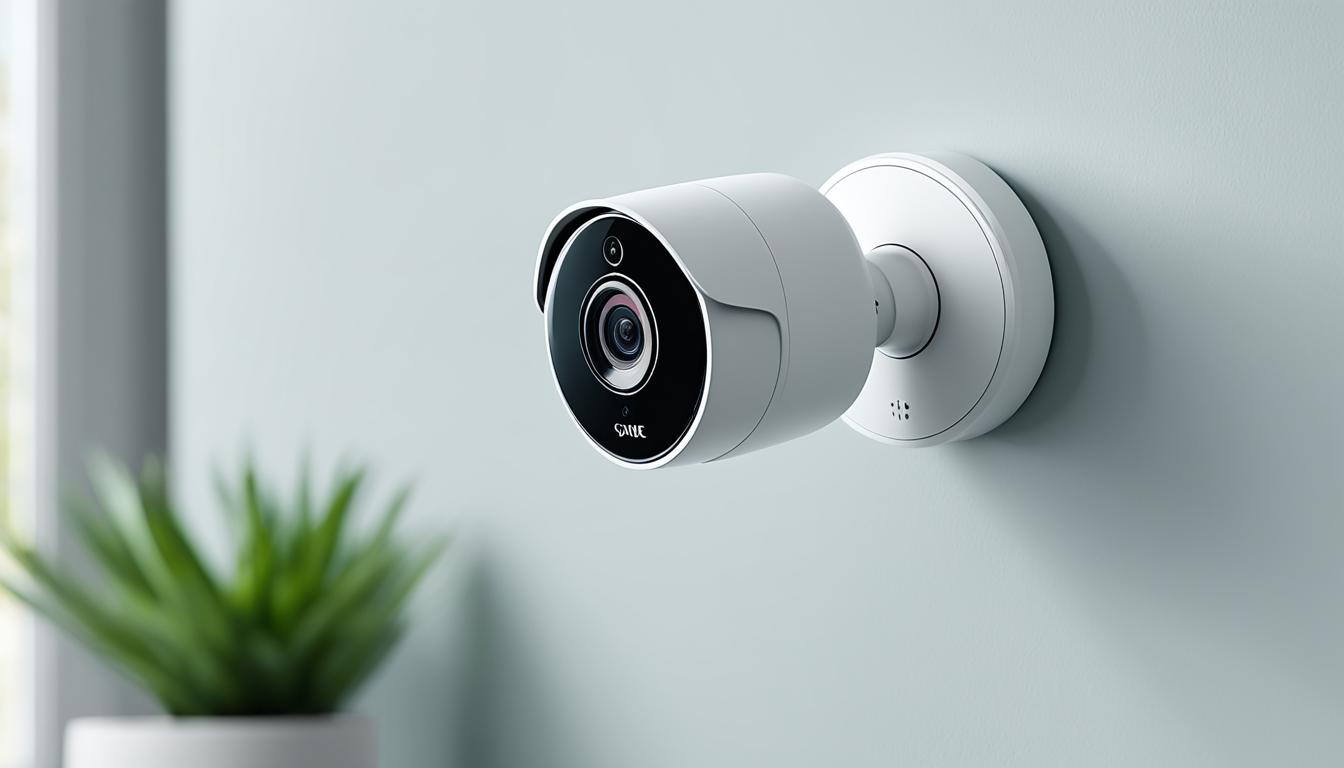As a homeowner, you want your home to be comfy and your energy bills low. Google Home lets you control your thermostat with voice commands. But, this can be a problem with kids around. They might change the settings, wasting energy and making your home uncomfortable.
To stop this, you can use Google Home’s parental controls. You can also set limits on who can change the thermostat settings.

With these controls, you can stop kids from messing with the thermostat. This way, your home stays comfy and your energy bills stay low. Google Home’s features help you keep your home just right, without kids messing with it.
Introduction to Thermostat Control
Using Google Home’s parental controls, you can limit who can change the thermostat. This keeps your home comfy and saves energy. By setting up these controls, you can stop kids from messing with the thermostat and save energy.
Key Takeaways
- Keep kids from controlling the thermostat with Google Home’s parental controls
- Set up restrictions for thermostat access to maintain a comfortable temperature
- Use Google Home’s features to restrict access to the thermostat
- Prevent kids from adjusting the thermostat settings
- Reduce energy waste and keep your energy bills in check
- Maintain a comfortable temperature in your home with Google Home
Why Children and Thermostats Don’t Mix: Understanding the Challenge
As a homeowner, you want your kids to be comfortable at home. But managing their access to smart devices like Google Home can be tough. It’s important to stop them from changing the thermostat to keep the temperature right and save energy.
Kids messing with the thermostat can cause problems. They might change the temperature without knowing the effects. This can lead to higher energy bills and a less comfortable home. Teaching kids about smart home use is key to solving this issue.

- Energy waste from too much heating or cooling
- Higher energy bills
- Discomfort from extreme temperatures
Knowing these problems helps you limit thermostat access. This way, you can keep your home comfortable. You can manage your kids’ Google Home access and stop them from changing the thermostat.
Setting Up Your Google Home for Restricted Thermostat Access
To keep your home comfy and save energy, it’s key to limit thermostat control. Supervising thermostat settings for kids is also important. This way, you avoid unnecessary temperature changes, cut down on energy bills, and keep your home’s climate steady.
Google Home has features to help you control who can change the thermostat. Start by setting up parental controls and restrictions. This stops kids from messing with the thermostat settings. You can do this by making a special account for your kids and giving them limited access to Google Home.
Here are some important steps to follow for restricted thermostat access on Google Home:
- Creating a separate account for your kids
- Assigning limited access to the Google Home device
- Setting limits on thermostat control
- Supervising thermostat settings for kids
By following these steps, your home will stay comfy and energy-efficient. Plus, your kids will learn about using energy wisely. Always check and update your settings to fit your family’s needs.

How to Keep Kids from Controlling the Thermostat Google Home: Step-by-Step Guide
To stop kids from controlling the thermostat with Google Home, you need to take a few steps. It’s important to control Google Home access for children. This keeps your home comfortable and limits thermostat changes for kids. Start by creating individual voice profiles for each family member.
This lets you set who can use certain features. It’s great for parents who want to control the thermostat. It stops kids from making unnecessary changes.
- Create individual voice profiles for each family member
- Establish access permissions to restrict certain features
- Test your security settings to ensure they are working correctly
By following these steps, you can stop kids from controlling the thermostat with Google Home. This keeps your home comfortable and energy-efficient. It also limits thermostat changes for kids and stops unnecessary temperature adjustments.
Advanced Google Home Security Features for Temperature Control
Looking to keep your thermostat safe? Google Home has advanced security features for temperature control. These let you keep your home comfy without letting others mess with the temperature. Google Home makes it easy to control your home’s temperature securely.
Google Home’s security lets you limit who can change the thermostat. You can set up voice profiles and access permissions. This is great for families with kids, keeping them from messing with the thermostat.
Some cool features include:
- Customizable access permissions
- Individual voice profiles
- Temperature control scheduling
- Energy usage monitoring
These features help you manage your home’s temperature and energy use. They make controlling your thermostat secure and easy.
Using Google Home’s advanced security features makes your home more comfy and energy-smart. Temperature control is now simple, and your thermostat is safe and easy to handle.
Alternative Methods to Restrict Thermostat Access
Keeping your home at the right temperature can be tricky. You might want to look into alternative methods to keep the thermostat from being changed. This is great if you have kids who like to mess with the temperature. These methods help keep the thermostat settings just right for you.
There are a few ways to do this. You can use physical locks, smart home routines, or set time limits. These options can work together to give you more control over your thermostat.
- Physical thermostat locks: These locks can be installed on your thermostat to prevent unauthorized access.
- Smart home routines: You can set up smart home routines to automate your thermostat settings and restrict access to certain times of the day.
- Time-based restrictions: You can set up time-based restrictions to limit when the thermostat can be adjusted, such as during certain hours of the day or night.
Using these methods can help you keep your home comfortable. It also stops unwanted changes to your thermostat. This can save you money on your energy bills.
Teaching Kids About Temperature Management
As a parent, it’s key to get your kids involved in managing temperatures. This helps them learn good habits and see the value of saving energy. Start by talking to them about how their actions affect the planet and your bills.
When you talk to your kids about temperature, think about their age and what they know. Younger kids can learn with simple examples. Older kids can dive into deeper topics like how saving energy helps the planet.
To make your home cozy and energy-smart, set family temperature rules. Decide on a good temperature range for your home. Encourage your kids to wear the right clothes for the weather. This way, you all can stay comfy and save energy. Here are some ways to teach kids about managing temperatures:
- Encourage them to turn off lights and gadgets when not using them.
- Teach them to adjust the thermostat to a good temperature.
- Explain why saving energy is good for the planet.
Teaching kids about temperature management helps them develop good habits. It also makes your home comfy while cutting down on energy costs. Always talk openly with your kids about why managing temperatures and saving energy is important.
Troubleshooting Common Issues with Thermostat Restrictions
Setting up thermostat restrictions can sometimes lead to common problems. Troubleshooting these issues is key to making sure your thermostat works right. Issues often include wrong settings, devices that don’t work together, and software bugs.
To fix these problems, start by checking your thermostat settings. Make sure they’re right. Try restarting your thermostat or updating its software. If you’re still having trouble, look at your user manual or call the manufacturer’s support.
Here are some steps to troubleshoot common thermostat restriction issues:
- Check your thermostat settings to ensure that they are correct
- Restart your thermostat to see if it resolves the issue
- Check for software updates to ensure that your thermostat is running the latest version
- Consult the user manual or contact the manufacturer’s support team for assistance
By following these steps, you can find and fix common thermostat restriction problems. This ensures your thermostat works well and efficiently. Always check your thermostat’s user manual for specific troubleshooting tips.
Maintaining Comfort While Enforcing Boundaries
When you limit your kids’ access to the thermostat, finding a balance is key. You aim to keep your home cozy and save energy. At the same time, you teach your kids about handling temperature wisely. To do this, set temperature ranges that fit different times of the day and night.
For example, make the morning and evening warmer when everyone’s home. At night, when it’s quiet, the temperature can be cooler. This way, you save energy and keep everyone comfortable. Also, having a family temperature plan helps set rules and stops kids from messing with the thermostat.
- Adjust indoor temperature based on outside weather
- Think about family activities and schedules, like sleep and work times
- Make sure everyone knows the temperature plan and rules
By using these tips, you can make your home cozy and energy-smart. It’s good for everyone. Don’t forget to check and change your temperature plans and rules as your family grows and changes.
Conclusion: Keeping Your Home Comfortable and Your Kids in Check
Controlling your home’s thermostat with Google Home is key to a cozy and energy-saving home. This guide shows how to limit access to the thermostat. So, your kids can’t change the temperature.
Keeping your home comfy is linked to managing your kids. With Google Home, you can control the temperature easily. This means no sudden changes that mess up your day or raise your energy bills. Use Google Home to make your home a peaceful, climate-controlled space.
FAQ
How can I prevent my kids from controlling the thermostat with Google Home?
To stop your kids from controlling the thermostat with Google Home, set up parental controls. Create individual voice profiles and establish access permissions. Also, test your security settings to ensure they work.
What are the common issues with kids adjusting the thermostat settings?
Kids adjusting the thermostat can lead to energy waste and higher bills. It can also be a safety concern. They might not understand the impact of their actions, causing discomfort at home.
How can I set up Google Home for restricted thermostat access?
To limit thermostat access on Google Home, create voice profiles and set permissions. Test your security to ensure it works. This way, you can control who adjusts the thermostat.
What are some advanced Google Home security features for temperature control?
Google Home has advanced security for temperature control. You can restrict access to the thermostat. This keeps your home at a comfortable temperature, away from your kids’ control.
Are there any alternative methods to restrict thermostat access besides Google Home?
Yes, you can use physical locks on thermostats or set smart home routines. Time-based restrictions are also options. These methods help prevent kids from changing the thermostat settings.
How can I teach my kids about temperature management?
Teach your kids about temperature management with age-appropriate talks. Discuss energy usage and create family guidelines. This helps them develop good habits and understand the importance of a comfortable home temperature.
What are some common issues with thermostat restrictions, and how can I troubleshoot them?
Issues with thermostat restrictions include wrong settings, device incompatibility, and software glitches. Check your settings, ensure device compatibility, and fix software problems to solve these issues.
How can I maintain comfort while enforcing boundaries for thermostat access?
To keep your home comfortable while setting thermostat boundaries, set reasonable temperature ranges. Create family temperature schedules. This balance ensures comfort and energy efficiency in your home.











